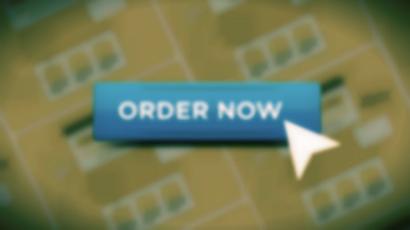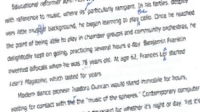| |
Long Copy vs. Short Copy: The Definitive
Guide
by Marcia Yudkin
“Why the heck do they write those long, long sales letters, the ones that blab on and on forever? They can’t possibly work!”
More misconceptions circulate about long copy than about any other issue in copywriting. They come up from people learning copywriting, from business owners who use a limited repertoire of marketing tools, from opinionated prospective copywriting clients and from folks thrust unexpectedly into marketing for their organization.
|
The quick answer is that longer copy usually sells better than shorter copy, but not always.
From Claude Hopkins and David Ogilvy to Bob Bly and Jay Levinson, all the advertising experts with the deep pockets to test long against short copy or to know about clients’ in-house tests report that long copy wins, most of the time.
Once you understand the reasons for this, and the principles of persuasion and communication at work in long copy, you will find this truth more believable, even in an age of
YouTube, Twitter and 10-second attention spans.
You’ll be in a better position to punch down common yet mistaken objections to long copy, defend it to skeptical colleagues or customers and use writing to sell.
Why Does Long Copy Work?
Copywriting is salesmanship in print. A written sales pitch substitutes words on paper or on a computer screen for face-to-face interaction about a product or service.
Think about purchases you’ve made out and about in the world where you needed to ask a lot of questions – purchases like life insurance, a new heating system for your house, college or day care for your kids, or discretionary surgery.
Then imagine a roomful or stadium full of people who, like you, are considering one of those items. Clearly the list of things someone in that group wants to know before signing on the dotted line is quite extensive. |
|
|
What Say the Greats?
David Ogilvy: “Claude Hopkins once wrote five pages of solid text for Schlitz beer. In a few months, Schlitz moved up from fifth place to
first... We have even been able to get people to read long copy about gasoline.”
John Caples: “If your ad is interesting, people will read all the copy you can give them. If the ad is dull, short copy won’t save it.”
Claude Hopkins: “The more you tell, the more you sell.”
Victor Schwab: “The sludge of human inertia is so stagnant that too small an amount of copy cannot make that sludge flow into action. It’s a rare copy idea that can be presented with great brevity and still get immediate action.”
Bob Stone: “The longer you hold a prospect’s interest, the more sales points you can get across and the more likely you are to win an order.”
Jay Abraham: “If your sales letters are interesting, people will gladly read them. Edit ruthlessly for waste or boring content, but never jettison fascinating facts, forceful reasons, or specific information that adds to your compelling story.”
Jay Conrad Levinson: “Don’t be afraid to use lengthy copy. Of all the things people dislike about marketing, ‘lack of information’ comes in second, after ‘feeling deceived.’” |
Long copy organizes in a compelling and interesting way the facts and reasons customers need to make their decision to buy, without the presence of a sales representative.
The more complex or expensive the purchase, the more long copy is needed. After all, the more we’re spending, the more we care about making a wise decision. The less we understand something, the more questions we tend to have. The more consequential a purchase, the more worries and concerns come to the surface and must be dealt with. Long copy not only meets the needs of the customer before buying, it also reduces the misunderstandings that lead to dissatisfaction and refund requests.
|
Write
an Effective, No-Hype Long
Sales Page
Follow the steps in a
new online copywriting
course to create a thorough,
non-obnoxious, persuasive
sales page for your own (or
a client's) event, coaching
program, tour, retreat,
infoproduct, etc.
Learn to write
long sales copy. |
|

Long Sales Copy Online
Course |
|
The more intangible or distant the purchase, the more long copy is needed. Before we sign up, we can’t touch, feel or gaze upon a European package tour, customized software or our career after graduating from trade school. Words – aided by pictures in some cases – must evoke the richly convincing kind of wanting we feel in a showroom next to a sample car we’re given the opportunity to drive.
Simple, inexpensive and inconsequential purchases don’t require long copy. If you think about your own buying behavior and that of customers, however, you’ll realize that few things in life are simple. Ever seen someone take a $2 item off the supermarket shelf, read every word on the package with a scrunched-up face, hesitate and then put it back? That’s a product that probably needed more information and explanations.
Indeed, I would say that the Number One flaw in student copy when I’ve taught copywriting is writing too little, leaving too many angles and concerns
unaddressed.
But There’s Much Too Much To Read!
If you saw the movie “Amadeus,” you probably snickered when Emperor Joseph II complains that Mozart’s music had “too many notes.” The objection that long sales letters contain too many words is just as off the point. First, just as music listeners get an impression of an overall melody without listening carefully to every little note, readers of long sales copy take in the overall message of the piece without reading every last word.
|
Learn From the
Masters of On-the-Level Copywriting
|
Two
years in a row, Marcia Yudkin
convened the world's most
distinguished practitioners of
no-hype copywriting to discuss the
art of writing copy that persuades
without excessive showmanship or
stretching of the truth.
In
2013, the A-list
telesummit presenters
were Nick Usborne, Steve
Slaunwhite, Ray Edwards,
Shel Horowitz and Marcia
Yudkin. In 2014
the telesummit tackled storytelling,
positioning, voice,
using metaphors and
search-engine-friendly
copy.
Get the No-Hype Copywriting Telesummit
recordings. |
 |
|
In fact, skillful copywriters deliberately plan for what they call a “dual readership path” in a long sales piece. Some readers do nothing but skim the headlines and subheads. Some skim the headlines and subheads, then go back and read the whole thing through. Still other readers read everything consecutively their first time through. But the text is written and formatted in such a way that whether readers skim or read carefully, the main argument clearly comes across.
Veteran copywriters understand that when they’ve done their best job possible, those who skim and quit or who quit after reading a few paragraphs down from the top were not going to buy anyway. The time wasn’t right for them, or they have no need or want for the offering. Those who are keenly interested and open to buying now do willingly read that many words – avidly.
If you find that hard to believe, ask any of your friends who recently planned a faraway vacation. Chances are, they devoured as many short online reviews as they could find before deciding which city to fly to and where to stay. As I said above, a long sales letter performs the equivalent of collecting all the disparate points in one place. Someone who has no interest in Dubrovnik right now would find all that research and reading boring. But so what?
Successful long copy is never long just to be long or to reach some predetermined optimal length. It becomes that long because the copywriter has more to cover when asking people to step forward to buy. When the text is relevant, well written and well constructed, the reader does not experience it as overly long.
Other Common Objections to Long Copy
I don’t read long sales letters, so they couldn’t possibly work.
Always beware of generalizing from your personal habits and likes/dislikes to those of your customer. In addition, many of us have mistaken beliefs about our own behavior. One of my copywriting colleagues remembers a workshop where participants vociferously insisted that they never paid attention to advertising mail. Yet every last one of them had landed in the workshop in response to a sales letter in their mail.
When I see a long sales page, I instantly think “scam.”
Again, it’s wrong to assume that everyone in your intended market resembles you. Remember also that your long sales letter doesn’t have to have the look that you associate with hyped-up marketing. It need not feature blood-red headlines, an exaggerated tone, predictable phrases, bonus piled upon bonus and clichéd illustrations. Give it a fresh design, an authentically conversational tone, pleasantly creative writing, a matter-of-fact offer and unexpected graphics and most readers will regard it without prejudices.
Maybe long copy works in Internet marketing, but not for my customers. Your customers are smart, sophisticated or no-nonsense individuals, not the pathetically dumb suckers who buy Internet marketing products, right? That may be true. Nevertheless, classic long sales letters have sold subscriptions to the Wall Street Journal, adventure travel, limited-edition art, donations that save lives around the world and just about every investment newsletter ever published. You can’t know whether or not long copy would work for you unless you try it.
 |
Improve Your
Proofreading
Quick online course teaches how to
catch pesky typos. Whether you check
writing on screen or on paper, learn the
stakes for error-ridden copy, the five
best proofreading methods and the tools
you can or shouldn't use to identify
errors. Includes practice tests and
answers.
Proofreading Hacks course. |
Maybe long copy once worked, but not today, with everyone’s minuscule attention spans and demanding schedules.
The best reality check for this is your own mailbox. Even with today’s high postal rates, you’re probably still receiving credit card offers, invitations to conferences, life insurance solicitations and subscription promotions related to your hobbies – each of which takes three or more pages to set
out
its arguments. The same goes for your email in-box, which most likely contains messages every day from vendors you trust asking you to click to landing pages that would take up six or more pages if you printed them out. Companies spend time, money and effort sending you such promotions because they continue to produce results.
When Short Copy Shines
Despite all the above, long copy isn’t always needed or appropriate. Short copy may be able to get the job done quite well in these instances:
-
When readers are already primed to buy
-
When the item is a known commodity
-
Where space is limited, as in a catalog
-
With a low-risk, low-priced purchase or opt-in
-
With non-readers
-
When photos can convey most of the story
-
Where the copy serves as a prelude to interaction with a sales representative
Your Results May Vary
Did you notice that I hedged the superiority of long copy in my introduction with “usually” and “most of the time”? That wasn’t a copout. It reflects the reality that so many factors come into play in selling through the written word – the offer, the audience, the promotional medium, timing and more – that long copy doesn’t always produce better results. Professionals constantly test, and you should, too.
Marcia Yudkin is the author of Meatier Marketing Copy, Persuading on Paper and 14 other paperback books as well as a copywriting mentor and copywriter for publishers, Internet entrepreneurs, consultants and financial services firms.
Copyright 2012 Marcia Yudkin.
All rights reserved. Please link to this
page but do not reprint it online or offline
without written permission.
Read
more articles about copywriting.
Become a
successful marketing consultant / copywriter.
Hire
Marcia Yudkin to write or rewrite sales letters,
brochures, web sites, flyers, press releases or
other marketing materials.
|









